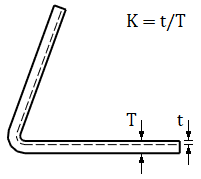K-Factor
Sheet-Metal Design
K-Factor refers to both the name of a parameter program used by Vertex and the geometric property of a bent sheet.
The parameter program K-Factor is a way to take into account the deformations caused by the bending of a sheet. When K-Factor is in use, you can define a K-Factor (geometric property) for each bend separately in flattening, sketch-based bend and converting a 2D drawing to 3D model. You can enable K-Factor by selecting it as the stretch calculation method in the Sheet Metal Parameters dialog box.
K-Factor as a geometric property refers to the relative position of the neutral plane within the sheet, which is demonstrated in figure 1. The neutral plane is the plane whose length doesn't change in the bend. K-Factor can have values between 0 and 1, but typically the values are between 0.3-0.5. The value 0.5 means that the neutral plane is at center of the sheet which means that the sheet doesn’t stretch at all. This is the same as the Vertex parameter program NOSTRETCH. The default value for the K-Factor is 0.5 but you can change it in the system preferences in the section bend (in administrator's view) with the keyword BendKFactor.

The K-Factor depends on the material, its thickness and the bending machine. There are general rules for the K-Factor for certain materials and bending methods, and some material suppliers may report suitable K-Factors for their materials. These may help in finding an approximate K-Factor, but the only way to find out the exact value of the K-Factor is to determine it experimentally with known machinery.
